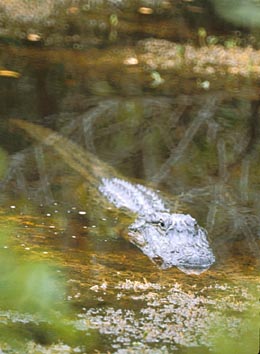
Note: Watch this area for additional navigation information in each section!


The Alligator: Keeper of the Everglades
Out in the sunny glades the broad leaves of the alligator flag mark the location of an alligator hole. This is the most incredible ecosystem of all the worlds within the world of the park; for in a sense the alligator is the keeper of the Everglades. With feet and snout these reptiles clear out the vegetation and muck from the larger holes in the limestone. In the dry season, when the floor of the glades checks in the sun, these holes are oases. Then large numbers of fish, turtles, snails, and other freshwater animals take refuge in the holes, moving right in with the alligators. Enough of these water-dependent creatures thus survive the drought to repopulate the glades when the rains return. Birds and mammals join the migration of the everglades animal kingdom to the alligator holes, feed upon the concentrated life in them -- and in turn occasionally become food for their alligator hosts. Lily pads float on the surface. Around the edges arrowleaf, cattails, and other emergent plants grow. Behind them on higher muckland, much of which is created by the alligators as they pile up plant debris, stand ferns, wildflowers, and swamp trees. Algae thrive in the water. The rooted water plants might become so dense as to hinder the movement and growth of the fish, were it not for the weeding activities of the alligators. With the old reptiles keeping the pool open, the fish thrive, and alligators and guests live well. Plants piled beside the hole by the alligator decay and form soil with mud and marl. Ferns, wildflowers, and tree seedlings take root, and eventually the alligator hole may be the center of a tree island. So, it's easy to see how important the alligator is to the ecology of the park. Unfortunately for this reptile, many people in the past believed only in the value of its hide. Hunting for alligators became profitable in the mid-1880s and continued until the 1960s. In 1961 Florida prohibited all hunting of alligators, but poaching continued to take its toll. Finally, the Federal Endangered Species Act of 1969 protected the alligator by eliminating all hunting and trafficking in hides. As a result of complete protection, the alligator has increased greatly in number. They are no longer an endangered species in Florida, and they can easily be found in gator holes and sloughs. Today alligators are eagerly sought by visitors to Everglades National Park who are anxious to see and photograph this unique creature. Once again, the alligator is the keeper of the Everglades.












